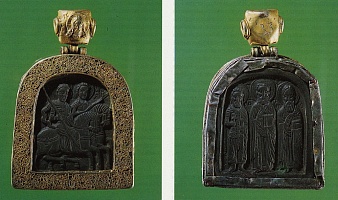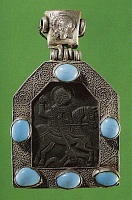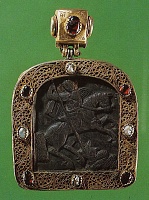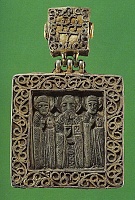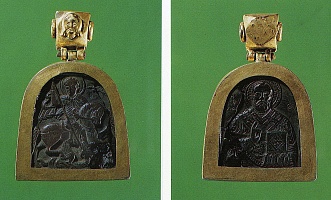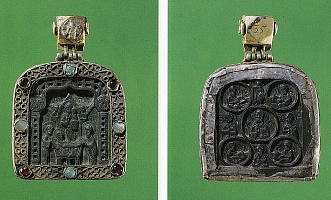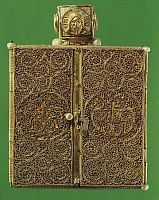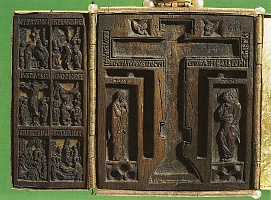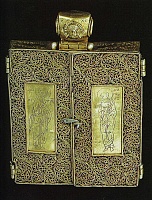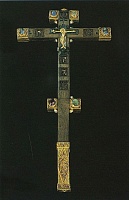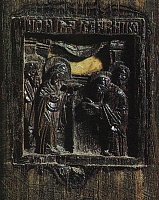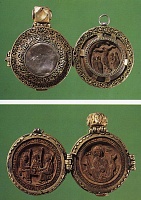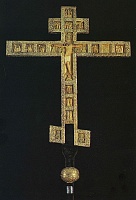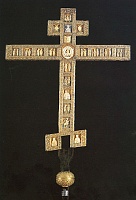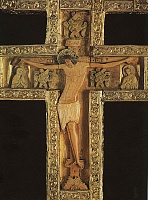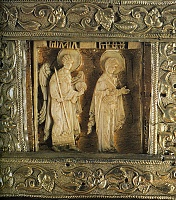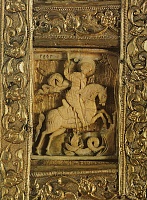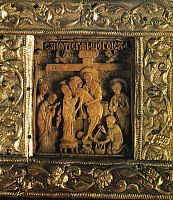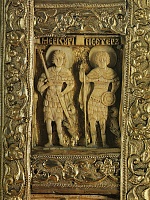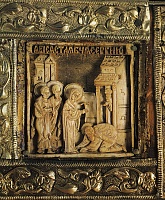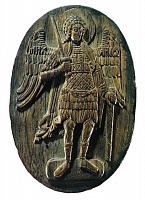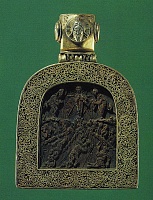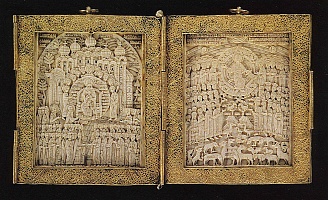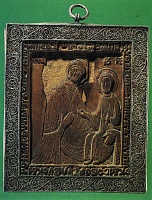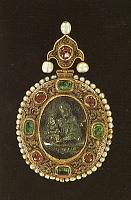Small-size Works of the 11th – 17th Centuries
Miniature carvings in stone, wood, bone, mother-of-pearl constitute an interesting part of the ancient collection. They are mainly various church objects: small icons, crosses, panagias that were wide-spread since ancient times. Made to individual order by professional artisans, they were always of special value for their owners. They were believed to be protectors that could defend people in possible troubles and guard their lives. Generally these icons and crosses were decorated with precious mountings. Like painted icons, embroidered icon-cloths and palls, miniature works were greatly appreciated and often donated to the monasteries. Their content demonstrates the great variety of Russian iconography. The main part of the collection comprises the 14th – 17th century works, but there are single items referring to the earlier period of the 11th – 13th centuries.
The Sergiev Posad Museum-Reserve possesses one the most comprehensive collections of this kind in our country, including the best samples of this kind. The surviving Monastery documents permit to date many items precisely, as well as, to reveal the symbolic meaning of the subjects they depict. The collection demonstrates the sequential development of Moscow craft and presents quite a number of interesting works connected with Ryazan, Vladimir and Suzdal, Novgorod and Tver.
The historical significance of particular samples and their belonging to representatives of different categories of the society determined the place of their preservation. Pectoral crosses and icons, as family “relics” sometimes depicting saints patrons, were fixed on the mountings of the most venerated icons. There were many such appendages on the icons depicting “The Trinity” and “St. Sergius and the Scenes from his Life” in the iconostasis of the Trinity Cathedral. The pectoral icons, crosses and panagias of the Monastery higher clergy were kept in the Monastery sacristy. The Monastery Treasury contained donations of the ostiaries and beadles, the Trinity elders and parish priests. A lot of items including miniature sculptures, confiscated from the disgraced princes and boyars, were preserved in the “Novgorod basket”.
The earliest part of the collection includes stone icons of the 13th – 14th cc. made of soft shale, slate and talcum. Miniature sculptures of that time, preserving pre-Mongolian traditions and showing distinct features of separate artistic schools, are of different style. The limited, yet characteristic group of images included the Virgin, Christ, St. Nicholas, SS George and Nikita.
The iconography of Moscow small-size sculptures reflected locally worshipped, patron saints and most popular church feasts. Stone icons with a carved image of St. George on horseback were wide-spread. This saint worshipping in Moscow Principality was probably connected with the name of Prince Yuri Dolgoruky. (the Long Armed) – the founder of Moscow. He constructed a number of churches, dedicating them to his patron saint, i.e. to St. George. The Moscow works frequently showed St. George on horseback on one side and St. Nicholas of Myra Lycia on the other. Such is one of the early slate icon of the 14th century.
The flowering of miniature wood-carving was connected with the works of Avbrose who lived in the Trinity-St. Sergius Monastery in the second half of the 15th century. His art stands with the creations of the best icon-painters in expressiveness, deep content and superb technique. Complicated many-figured compositions appeared in fine miniature wood-carving for the first time. In 1456, Ambrose made the three-fold icon of walnut in a gold filigree reliquary to the order of the Trinity Monastery hegumen Vassian.
Аmbrose carved lace-like miniatures and inserted them in rectangular reliquaries on both sides of the communion cross of walnut. The obverse depicts the Trinity, the Annunciation, the Nativity of Christ, Meeting of the Lord, Baptism, Transfiguration; the reverse shows Raising of Lazarus, Entering Jerusalem, Resurrection, Descent of the Holy Spirit to the Apostles, the Assumption of the Virgin, the Appearance of the Virgin to St. Sergius of Radonezh, Beheading of St. John the Baptist. The small panagia, carved in oak and set in a gilded silver filigree frame, reveals features characteristic of Ambrose works.
28 ivory carved plaques of the late 15th century, that were once inserted in the earlier cross, decorate now the altar cross of the 17th century. They are in gilded cases shining through the lace-like compositions. The compositions character and carving methods prove the work of several craftsmen. Ambrose probably made figures of Christ in the Crucifixion, Angels in the Trinity, the Virgin and Archangel Michael from the Deesis range, St. George, St. Gerasim with a lion and the Deposition from the Cross.
The images in other miniatures, made by professional craftsmen as well, are different. The saint warriors Mercury and Nestor are the most interesting figures among them. The iconography of the compositions on the cross is worthy of attention. The variant of the scene “The Appearance of the Virgin to St. Sergius of Radonezh” differs from the same composition on the altar cross. The Virgin is accompanied by two Apostles, St. Sergius is kneeling at her feet, St. Micheas is seen in the opening of the cell.
Wood and ivory carving, brought to perfection by Ambrose, existed in the Monastery in the subsequent centuries. In the second half of the 16th century, complicated many-figured compositions were wide-spread. They were mainly carved in wood and ivory, works of stone were not so numerous as in the previous century. The iconography of small-size sculpture was developing. On the other hand, it was nationally prescribed to follow the official cannons that resulted in certain regularity. “The Transfiguration” icon, donated by Princess Kilikia Ushataya (?) and the diptych with the ivory carved compositions “In Thee Rejoiceth” and “Praise to the Holiest” are characteristic specimens of that time.
In the 16th century the Trinity Monastery was a kind of workshop producing pectoral icons, crosses and panagias in large amount. The works carved in wood and in bone were mass produced for the Monastery clergymen and for sale. The Monastery documents recorded the names of the craftsmen: “Eusebius – a cross maker”, Pyotr – “a silversmith”. The artistic techniques of Ambrose carving were used in the icon of oak donated by Kilikia Ushataya. The Trinity carvers made two folding icons with complicated many-figured compositions (one depicting the Trinity, the Appearance of the Virgin to Sergius of Radonezh and the Crucifixion donated by the Trinity elder Vassian, the other – the Crucifixion, the Virgin of the Sign, the Trinity, SS Sergius and Nikon of Radonezh. The best specimens of the Trinity and Moscow masters were copied, yet distorted by the provincial craftsmen. That could be observed in numerous castings common in the northern and southern provinces. Metal engravings of the 16th century were closely connected with miniature sculptures in pectoral icons, panagias and crosses .
The Museum collection of the 17th century carved works is comparatively small. At that time complicated carvings were replaced by brass castings that were sometimes made from the ancient moulds. At the same time the pectoral icons, crosses and panagias turned from “relics” to decorative objects. Their precious settings played a considerable role. They were often adorned with magnificent filigree, enamel and chasing.










